As Hinduism is the oldest religion on the earth, it has more numbers of symbols than other religions. Each Hindu symbol has a different meaning and is used on different occasions. Hinduism symbols are also used as body tattoos in the Western countries as well as in India. Hinduism signs and symbols are very popular in India and are also known as Indian symbols. We are providing here a comprehensive list of major Hindu symbols and their meanings.
Om or Aum
 Aum, also known as, Om, is the most important symbol in Hinduism. It is made up of three Sanskrit letters namely A, U, and M and is written as No. 3 with a curved line like a tail going out from the center on the back side of three with a moon-shaped curve and a dot above 3. All the major Hindu mantras start with Aum. Aum represents Brahman, the Almighty. You would understand the importance of this symbol by this only. It is the sound heard at the time of creation of universe. It is considered as sacred and is worn in pendants, rings, printed on T-shirts, cups, temple walls.
Aum, also known as, Om, is the most important symbol in Hinduism. It is made up of three Sanskrit letters namely A, U, and M and is written as No. 3 with a curved line like a tail going out from the center on the back side of three with a moon-shaped curve and a dot above 3. All the major Hindu mantras start with Aum. Aum represents Brahman, the Almighty. You would understand the importance of this symbol by this only. It is the sound heard at the time of creation of universe. It is considered as sacred and is worn in pendants, rings, printed on T-shirts, cups, temple walls.
Swastika
Swastika is the second most important Hindu symbol. Swastika looks like the Nazi symbol. The only difference is Nazi symbol is tilted as if standing on one point while the Hindu symbol seems as if standing on a horizontal branch. The word Swastika can be broken as Su+Asti+ka where Su means good and Asti means "it really is" and "ka" makes the word a noun. That means "Everything is good". Swastika is also considered to be sacred and represents luck and prosperity. A Swastika is drawn on Kalash at the time of Hindu rituals. It is also used in pendants and printed on walls of the Hindu temples.
Tilak
 Tilak is a vertical sign made by kumkum on the forehead exactly between two eyebrows of a Hindu male. This is used mainly at the time of rituals or any religious ceremonies like weddings, birthdays, Munj, etc.
Tilak is a vertical sign made by kumkum on the forehead exactly between two eyebrows of a Hindu male. This is used mainly at the time of rituals or any religious ceremonies like weddings, birthdays, Munj, etc.
Lingam
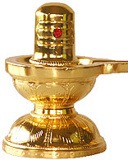 Lingam is the representation of Lord Shiva through which Lord Shiva is worshipped mostly. The lingam is also called Shivling, Ling. It is a vertical cylindrical pillar surrounded by a nearly completely round object with an opening on the right side which stretches out to some length. The interpretation of this Hindu symbol is controversial as some people believe that it is a union of the Linga of Shiva and Yoni of Shakti while others believe that it represents the infinite nature of Shiva. Most of the Hindus worship Lord Shiva in the form of a lingam instead of an idol of Lord Shiva.
Lingam is the representation of Lord Shiva through which Lord Shiva is worshipped mostly. The lingam is also called Shivling, Ling. It is a vertical cylindrical pillar surrounded by a nearly completely round object with an opening on the right side which stretches out to some length. The interpretation of this Hindu symbol is controversial as some people believe that it is a union of the Linga of Shiva and Yoni of Shakti while others believe that it represents the infinite nature of Shiva. Most of the Hindus worship Lord Shiva in the form of a lingam instead of an idol of Lord Shiva.
Trishul
 Trishul is a weapon with three points residing on a long rod with outer two points curved at the end and the middle point straight and sharply pointed. Trishul is the main weapon of Lord Shiva which he always carries with himself and is highly revered in Hinduism.
Trishul is a weapon with three points residing on a long rod with outer two points curved at the end and the middle point straight and sharply pointed. Trishul is the main weapon of Lord Shiva which he always carries with himself and is highly revered in Hinduism.
Bindi
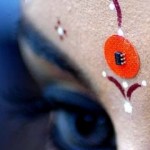 A bindi is a small rounded sign made with Kumkum between the two eyebrows of a married Hindu woman. Though unmarried girls also use the sign but they do not use Kumkum for that.
A bindi is a small rounded sign made with Kumkum between the two eyebrows of a married Hindu woman. Though unmarried girls also use the sign but they do not use Kumkum for that.
Kalash
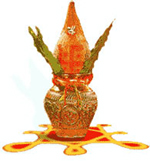 A Kalash is a vessel with five green leaves placed at the entrance of the vessel in such a way that they cover the entrance of the vessel and then a coconut placed on top.
A Kalash is a vessel with five green leaves placed at the entrance of the vessel in such a way that they cover the entrance of the vessel and then a coconut placed on top.
Yantra
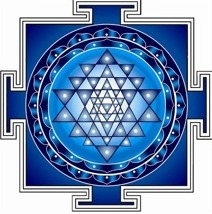 Yantra actually means a machine but when it is used as a Hindu symbol, it looks like a geometry figure. These are simple as well as complex figures. Sometimes numbers are written on it. If placed at a desired place, they are believed to have good effects on the life of the possessor.
Yantra actually means a machine but when it is used as a Hindu symbol, it looks like a geometry figure. These are simple as well as complex figures. Sometimes numbers are written on it. If placed at a desired place, they are believed to have good effects on the life of the possessor.
The saffron Colored Flag
 The saffron-colored flag is the official flag of Hinduism. It looks like two partial triangular waves connected to each other in the middle and flat at the other end. Saffron color represents sacrifice and renunciation of materialism.
The saffron-colored flag is the official flag of Hinduism. It looks like two partial triangular waves connected to each other in the middle and flat at the other end. Saffron color represents sacrifice and renunciation of materialism.
Rudraksha Bead
Rudraksha is a tree whose seeds are traditionally used by Hindus for medicinal as well as spiritual purpose. Rudraksha is a dark-brown colored seed with some linings on it. Rudraksha is believed to be of 1 to 108 faces. One-faced Rudraksha is scarcely available.
Lotus
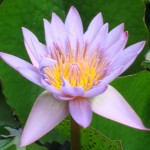 The flower of lotus is of great importance in Hinduism. It represents culture and politeness. You will see lotus in the hands of some important Hindu deities such as Lord Ganesha and some goddesses. A main Hindu deity Brahma is always shown sitting in the big lotus. The flower of lotus is used in some Hindu rituals.
The flower of lotus is of great importance in Hinduism. It represents culture and politeness. You will see lotus in the hands of some important Hindu deities such as Lord Ganesha and some goddesses. A main Hindu deity Brahma is always shown sitting in the big lotus. The flower of lotus is used in some Hindu rituals.
Shankha (Conch Shell)
Shankha is used both as a symbol and as a trumpet in Hindu rituals. Shankha is a sea shell which is kept inside Hindu altars and worshiped. Shankha is an emblem of Hindu God, Lord Vishnu. Shankha is a symbol of longevity and prosperity for Hindus. In ancient times, Shankha was used as a trumpet before the start of the war.
Dharmachakra
 Dharmachakara, means the Wheel of Dharma, represents Hindu Dharma or law. This wheel has eight spokes to it.
Dharmachakara, means the Wheel of Dharma, represents Hindu Dharma or law. This wheel has eight spokes to it.
Lamp
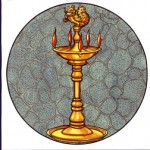 You will always find this lamp near the Hindu altar and/or in Hindu temples. Hindus believe that a lamp should always be lit near the Hindu deities. Many cultural and social functions in India are opened with lighting the lamps by chief guests. This lamp symbolizes the light and hence is sacred.
You will always find this lamp near the Hindu altar and/or in Hindu temples. Hindus believe that a lamp should always be lit near the Hindu deities. Many cultural and social functions in India are opened with lighting the lamps by chief guests. This lamp symbolizes the light and hence is sacred.
Banyan Tree
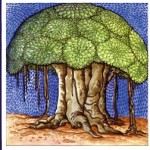 Banyan tree is a Hindu symbol of longevity. It is not only a Hindu symbol but also is national tree of India. Hindu married women worship this tree on Vat Pournima and tie a white thread around it asking for the longevity for their husbands.
Banyan tree is a Hindu symbol of longevity. It is not only a Hindu symbol but also is national tree of India. Hindu married women worship this tree on Vat Pournima and tie a white thread around it asking for the longevity for their husbands.
Nandi
Nandi is a bull which is also the carrier of Lord Shiva. A nandi is always found in front of a Shivlinga. It is a symbol of Lord Shiva. It represents strength and fertility.
Shri
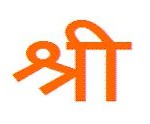 Shri or Sri is another most important symbols of Hindus. Shri represents auspiciousness. It also is one of the names of Lord Ganesha. Shri is added before the names of Hindu males as Mr. is added in English. It is used as short form of Shriman in this regard. It is also a symbol of Devi Laxmi.
Shri or Sri is another most important symbols of Hindus. Shri represents auspiciousness. It also is one of the names of Lord Ganesha. Shri is added before the names of Hindu males as Mr. is added in English. It is used as short form of Shriman in this regard. It is also a symbol of Devi Laxmi.
Ganesha
 Lord Ganesha is an important demi-God of Hindus but he is also used as a symbol many times. This symbol represents auspiciousness as Ganesh is known as remover of obstacles. Lord Ganesha is worshiped first of all demi-Gods. Hindus wear Ganesha symbol as a pendant or print his pictures in the house. Some people use metal rings on which Ganesha is carved.
Lord Ganesha is an important demi-God of Hindus but he is also used as a symbol many times. This symbol represents auspiciousness as Ganesh is known as remover of obstacles. Lord Ganesha is worshiped first of all demi-Gods. Hindus wear Ganesha symbol as a pendant or print his pictures in the house. Some people use metal rings on which Ganesha is carved.
Kamandalu
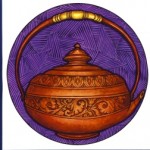 Kamandalu is an oblong vessel mainly used by ascetics who live in forests and do meditation. It is a symbol of asceticism. It is mainly used to store water. It looks like a Kalash but it is different from it.
Kamandalu is an oblong vessel mainly used by ascetics who live in forests and do meditation. It is a symbol of asceticism. It is mainly used to store water. It looks like a Kalash but it is different from it.
Kamadhenu(Cow)
 Cow is the most sacred animal for Hindus. It is considered as a very poor animal. Cow is a symbol of good nature, purity, motherhood, and prosperity.
Cow is the most sacred animal for Hindus. It is considered as a very poor animal. Cow is a symbol of good nature, purity, motherhood, and prosperity.
Sudarshan Chakra
Sudarshan Chakra is a weapon as well as a symbol of Lord Vishnu. It is considered as the most lethal weapon. It is circular in shape like a flat disc and is toothed as a saw around the circumference.
Veena
Veena is a musical stringed instrument of Goddess Saraswati but it is also a Hindu symbol of art and education. It is also associated with Dev Rishi Narad.
Paduka
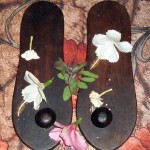 Paduka actually means footwear, the wooden slippers wore by saints and Hindu deities. Laxmi Paduka is the symbol of wealth. The footprints of Hindu deities and saints are also called as Paduka and are worshiped as a symbol of that deity.
Paduka actually means footwear, the wooden slippers wore by saints and Hindu deities. Laxmi Paduka is the symbol of wealth. The footprints of Hindu deities and saints are also called as Paduka and are worshiped as a symbol of that deity.
Peacock Feather
The peacock feather is the symbol of Lord Krishna as he used to wear a feather in his crown. Sometimes, a flute with peacock feather is depicted as the symbol of Lord Krishna.
Symbols of a Married Hindu Woman
Hindu women wear some ornaments as a symbol of marriage including but not limited to Mangalsutra (the sacred thread), bangles, Jodawe (a silver ring wore in the toe), ear-rings, nose-rings, etc. These symbols vary according to the region. Different things are used as symbol of marriage in different parts and societies in India. Besides those, Hindu married women apply Kumkum between the two eyebrows and on the center of the head.
Sun
Sun is considered as a deity by Hindus and is also a symbol of light and truthfulness. Sun worship is still prevalent in Hinduism. People offer water to the sun in the morning.
Snake
Snake is a symbol of rebirth as it casts its skin after a period of time. Lord Shiva always wears a cobra around his neck and Lord Vishnu rests on a snake named Sheshnaga.